Method and apparatus for combination of localization microscopy and structured illumination microscopy
a technology of localization microscopy and structured illumination, applied in the field of fluorescent microscopes, can solve the problems of limited ability, long acquisition time, and small and achieve the effect of reducing the size of the illuminated region of the sampl
- Summary
- Abstract
- Description
- Claims
- Application Information
AI Technical Summary
Benefits of technology
Problems solved by technology
Method used
Image
Examples
Embodiment Construction
[0042]The term “fluorescence” within the scope of the present application, is to be understood as any photon-interaction wherein there are differences between the illumination, respectively excitation spectrum, and the emission spectrum of the same object which cannot be explained based on the monochromatic absorption only. That includes for example in particular multiphoton interactions, by which the excitation wavelengths can be greater than the emission wavelengths. Thus the term fluorescence will be also used in the sense of this application for the closely related phenomena as “luminescence” and “photophosphorescence” or short “phosphorescence”. This includes in particular the cases of longer fluorescence duration, for example in the millisecond range. The use of phosphorescent optical labels, respectively the use of phosphorescent molecules for optical labeling instead of fluorescent molecules may be for example advantageous in view of improving the in vivo applicability of th...
PUM
| Property | Measurement | Unit |
|---|---|---|
| angle | aaaaa | aaaaa |
| angles | aaaaa | aaaaa |
| angles | aaaaa | aaaaa |
Abstract
Description
Claims
Application Information
 Login to View More
Login to View More - R&D
- Intellectual Property
- Life Sciences
- Materials
- Tech Scout
- Unparalleled Data Quality
- Higher Quality Content
- 60% Fewer Hallucinations
Browse by: Latest US Patents, China's latest patents, Technical Efficacy Thesaurus, Application Domain, Technology Topic, Popular Technical Reports.
© 2025 PatSnap. All rights reserved.Legal|Privacy policy|Modern Slavery Act Transparency Statement|Sitemap|About US| Contact US: help@patsnap.com



